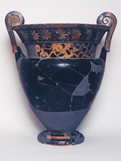After World War II, the Department of Art and Archaeology at Princeton was ready to return to archaeological fieldwork, having suspended excavations at Antioch following the outbreak of the second world war. Erik Sjöqvist, director of the Swedish Institute in Rome, had joined the department in 1951. With the support of Professor Earl Baldwin Smith, chair of the department, and Harold W. Dodds, president of the University, the decision was made to find a new site for the University to excavate.
In light of Princeton's prior archaeological involvement in the eastern Mediterranean, Sjöqvist spent the summer of 1953 investigating sites in that part of the world. In the end, however, he looked westward, finally selecting a mountain ridge in the hilly interior of central eastern Sicily. That site, known as Serra Orlando, was thought, and later proved, to be the location of the ancient town Morgantina. Sjöqvist and his colleague Richard E. Stillwell, who had excavated at Antioch and had served as director of the publications, surmised that, given its strategic location on a major line of communication between eastern and southern Sicily, the site must have been an important and rich center. Morgantina also provided two crucial opportunities: (1) to study the effect of Greek colonization on an indigenous population and (2) to train graduate students in the classical archaeology program. Sjöqvist completed negotiations with the Italian government, and excavations began in the summer of 1955.
Inhabited as early as the Bronze Age, Morgantina had an important Iron Age settlement of longhouses centered on an acropolis known as the Cittadella. In the second quarter of the sixth century B.C., buildings that are Greek in construction technique and decoration appear, and the cemeteries seen a major influx of imported Greek ceramics.

The early period of the city's history ended in 459 B.C., when the Sikel leader Duketios captured Morgantina in a vain attempt to free central Sicily from Greek control. The Serra Orlando plateau became the site of the city. In 396 B.C. Morgantina was captured by Dionysios of Syracuse, and for the next two centuries it remained in the Syracusan sphere of influence. It was its greatest period of prosperity and building during the third century BC as an outpost of the Hellenistic kingdom of Syracuse under King Hieron II. Morgantina's fate would change at the end of the third century B.C., when it took the wrong side in the Second Punic War, was sacked by the Roman army in 211 B.C. and given to Spanish mercenaries. This catastrophe was followed by a slow decline through the second and first centuries B.C., ending with the abandonment of the site in the first century A.D.
Sjöqvist and Stillwell jointly directed excavations at the site from 1955 to 1963 and again from 1966 to 1967, when Sjöqvist became ill and Stillwell retired. From 1968 to 1972, Hubert L. Allen, a former Princeton graduate student who was then professor at the University of Illinois, continued the excavations under the auspices of the jointly sponsored Illinois-Princeton Morgantina Expedition. William A. P. Childs, a professor in Princeton's Department of Art and Archaeology, who had been a trench master at Morgantina, returned to the site in 1978 and 1979 as field director. Childs sought to record all the information needed for the final publication of the excavations. In 1980, Malcolm Bell III, professor of classical archaeology at the University of Virginia, took over the supervision of the excavations. Today Morgantina is under the direction of Bell, who is responsible for Serra Orlando, and Carla Antonaccio, professor of classical studies at Wesleyan University, who directs work on Cittadella.